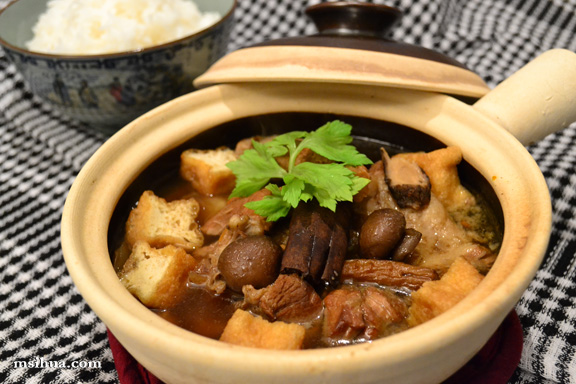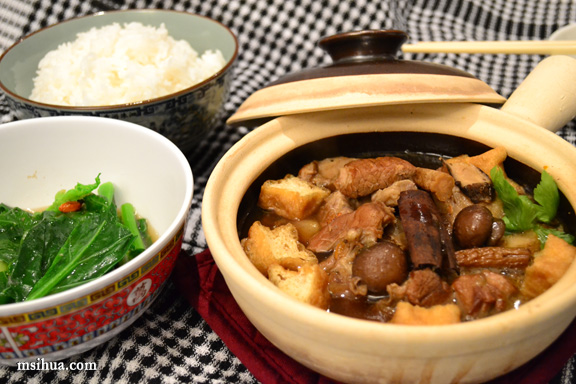Growing up in Malaysia, as I’ve mentioned countless of times, food is a central part of our culture.
Just the other day, I was trying to explain to my Australian colleagues about the norm of eating a hot bowl of laksa, roti, curry, nasi lemak, braised pork for breakfast during a farewell lunch yum cha.
I was telling them that yum cha is usually eaten during breakfast starting from 7 in the morning.
The look of horror and fear in their faces nearly had me rolling out of my chair in laughter.
One weak voice spoke up, “But if you want to have bread and cereal for breakfast you can, can’t you??!!” There was only a slight hint of panic in their voice.
A knowledgeable voice (not mine) added to the discussion, “Of course you can, most of their hotels there do serve cereal and milk!”
At that point, I had to violently cough into my napkin.
Now this next dish, some of you may associate it with braised pork. What Bak Kut Teh really translates into is Pork Bone Tea. Because that is literally what it is. Meaty pork bones, lashings of pork, and a lot of herbs (tea) braised for an hour or so (the longer the better really).
I have fond memories of having this during breakfast with Madam Mummy and Big Sis. In Malaysia, we like to associate popular dishes to their origin or to places that do them best.
For example, Kuala Lumpur Hokkien Mee, Penang Har Mee, Ipoh Hor Fun, Kajang Satay, Ampang Yong Tau Fu, you get my drift.
With Bak Kut Teh, it is usually associated with the suburb of Klang. But as with the other famous dishes listed above, you don’t necessarily have to travel to Klang to eat BKT, it would be great if you could, but not necessary.
Nowadays, whenever I head home for a holiday, I usually have this for dinner as well as supper with Madam Mummy.
Popular Klang BKT shops have sprouted up everywhere and most of them aren’t even close to the real thing. But if you know where to go, your tummy will be rewarded by a rich thick herbal broth. And only then, will you know the meaning of heavenly dishes.
Bah Kut Teh (Dark Version)
(Recipe adapted from Adam Liaw’s Two Asian Kitchens)
Ingredients:
For the Broth:
1 kg of Pork belly
500g of Pork ribs or meaty Pork bones
2 whole Garlic heads
2 tsp of Salt
1 Tbsp of Caster sugar
3 Tbsp of Light soy sauce
3.5 litres of Water
50g of dried Shiitake mushrooms – *we didn’t have any and therefore substituted them with Swiss brown mushrooms
5 Tofu puffs (fried or toasted – as long as they’re crispy), halved
10g Goji berries (Lycium barbarum)
For the Herb and Spice Bag:
20g Codonopsis Pilosula Root (Tang Shen)
20g dried Chinese Angelica (Dang Gui)
10g Lovage Root (Chuan Xiong)
20g Rehmannia Glutinosa (Shu Di)
5 slices of Licorice Root (Gan Cao)
20g Solomon’s Seal Root (Yu Zhu)
***Note: If you’re finding it hard to source some of the herbs above, get two packets of the Double Coins Brand Soup Stock (pink packet with Double Coins Brand logo on the top left in red) which contains Dang Gui, Tang Shen, Goji berries, and Yu Zhu (you can discard the Pilose Asihbell [white woody looking herb] as we won’t be using it). Alternatively (if you are extremely desperate), get a packet of A1 Bak Kut Teh Herbs (dark brown packet with A1 wording in yellow) which has majority of the herbs plus more – you can pick out the herbs required.
2 pieces of dried Tangerine peel
15g of Cassia Bark
6g of Star Anise
5g of White Peppercorns
To Serve:
3 sticks of Youtiao (sliced to serve) – *we didn’t have any and therefore omitted them. But they are highly recommended to soak up that heavenly broth.
Chopped coriander and spring onions (to serve)
3 sliced Birds Eye Chillies mixed with dark soy sauce (to serve)
Cooked Rice (to serve)
Procedure:
To prepare the herb and spice bag, rinse all ingredients and wrap them in a square muslin cloth, tying the ends to form a pouch.
Pour 3.5 litres of water (cold) into a large claypot (or stockpot) and add garlic and the herb & spice bag. Bring water to boil. Continue to simmer for 30 minutes with the lid covered. Using another pot, put the pork belly and ribs, fill with cold water (making sure it covers the meat) and bring to a boil. Once it starts boiling, remove the pork belly and ribs and add them to the boiling soup stock.
Add sugar, salt and soy sauce to the soup stock. Continue to simmer (lid covered) for 1.5 hours while skimming occasionally to remove any scum and fat.
While your stock simmers, soak the Shiitake mushrooms in hot water for 30 minutes and cut away the stems.
Remove all the pork from the soup and slice them up once they are cool enough to handle. Add your Shiitake mushrooms, tofu puffs and Goji berries into the soup and bring to a boil. After 20 minutes, remove the herb & spice bag. Add salt and sugar to season accordingly.
Put sliced pork and ribs into your serving bowl and pour hot soup to cover them. Place some mushrooms and tofu into the bowl. Garnish with coriander and spring onions.
Serve with rice, youtiao and sliced chillies in soy sauce.
If you would like a side of greens, drop some Asian greens (Chinese Brocolli works best, or Bok Choy) into a pot of hot boiling water for a few minutes (making sure they are not overcooked) and remove them to drain. Place them into a serving bowl and pour a ladle-full of Bak Kut Teh soup over it to serve.
So what do you usually have for breakfast? Is it any different from a heavy based full English breakfast?



omgoodness, my parents will love you for this recipe! When we went to Malaysia, it was the first meal that we went searching the streets for 😀
Yayyy.. now you can find it in your kitchen!
My brain read “Codonopsis” as “colonoscopy”. It struck fear into my heart.
Then I got over it and decided that the broth must be very very very delicious indeed.
You and I need to have a serious talk young lady.. Colonoscopy indeed! Harrummpphhh
But I don’t wanna have a serious talk about colonoscopies… :S
i made bak kut teh for my parents too…:)
Yum… I wish for this pot of goodness soon again..
OMG, yuuummmmm!!!! I am going to buy all those amazing herbal ingredients and try this recipe out too! Wonderful winter’s dish.
Normally used to the garlicky less herby BKT, but this dark herbal one just looks so good for the health. 🙂
Yeah.. it’s so worth it… the garlicky less herbal is the black pepper Singaporean clear version right?
I believe that what he meant and real yakky, personally preferred the black soup one for the great taste and flavor.
I think both of you need to be my neighbour… 🙂 I will be home for dinner every night.
And us for you too! Happy to go over you ur place if you weren’t on the other side of the universe!!
I am a fruit and cereal breakfast eater but this looks great once in a while 🙂
Its good every single day! Hahahaha
This is one of my favorite things! I can eat it any time of the day – breakfast, lunch, dinner, or supper. My herbal mixes (bought in Malaysia) are very precious and only used during the cooler months. I will have to hunt down those herbs that you mentioned. Thanks for sharing the recipe for the herbal mix. 🙂
Agreed.. anytime, anywhere! Yayy!
I have never cooked using pork belly- your soup looks amazing.
Never? OMG REN!… you have to cook it once!
BKT culture is indeed incomplete Boxer Revolution! Yes, TiongKok is number one but slave centre/factory of the world; Yuan is not even member of WB/IMF???…When are we standing up, not being called as “China” breakable porcelien but Zhongguok; Sino a Sinner…Subway, KFC and BigMac each restaurant runs into 40K but what happen, poor chinamen, we do not have even a restuarant with 50 outlets own by any single TiongHua brothers??? Interested? I am forming World BakGoodTeh Alliance to run 1Million BKT outlets globally…waits for your good respond. Amen
Oh thank you. I think I’ll pass this time 🙂
Hi Ms AiHua,good to see all those ingredients to make a great dish. If,only we readers can have a chance to look at those ingredients in pic so that its easier to know which is which. Thanks and keep sharing with your great recipes. God Bless !
traditional dish like bak kut teh should be all-natural and free from any food additive but the dark soy sauce usually sold in market contains preservative. i hope one day i’m able to find an organic version instead of the commercial one. am i being too health-conscious? i don’t know…
thanks for the post btw!
Nothing as too healthy these days 🙂 And you are welcome!
i saw other bak kut teh recipe calls for fresh sugarcane, fennel, dates, szechuan peppercorns, dried mandarin peels and luo han guo. do you think these ingredients will make bak kut teh tastes better?
This is for how many serving? 1Kg of pork belly + 500g of ribs?
This is great article
Thank you for the recipe
I will try to cook
Looking for the recipe of this great dish and found it here and will be trying it out.
Many thanks